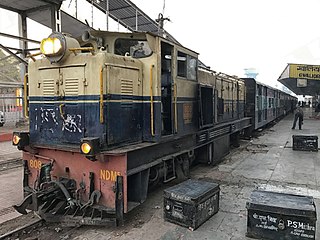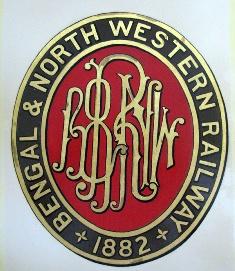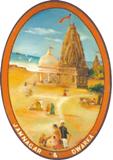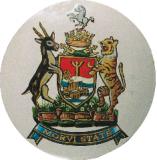Related Research Articles

The Bengal Nagpur Railway was one of the companies which pioneered development of the railways in eastern and central India. It was succeeded first by Eastern Railway and subsequently by South Eastern Railway.

The Madras and Southern Mahratta Railway was a railway company that operated in southern India. It was founded on 1 January 1908 by merging the Madras Railway and the Southern Mahratta Railway.
The Jessore–Jhenidah Light Railway was a 29-mile-long (47 km) 2 ft 6 in narrow gauge railway in British India, now in Bangladesh. It was constructed in 1913, and was dismantled in 1969. It operated 0-4-4T, 0-6-2T, 2-4-0T, and 0-8-0T locomotives of mostly German manufacture. The railway developed a reputation for being poorly managed, an official report in 1915 states that staff could not nominate one person as their manager.

Bengal Provincial Railway was a 2 ft 6 in narrow-gauge railway from Tarakeswar to Magra, in Indian state of West Bengal.

Bhavnagar State Railway (BSR) was a metre gauge railway line in Bhavnagar State, now part of Gujarat in India.

Gaekwar's Baroda State Railway (GBSR) or Gaikwad Baroda State Railway was a narrow gauge railway line owned by the Princely State of Baroda, which was ruled by the Gaekwar dynasty.

The South Indian Railway Company operated a number of 1,000 mm gauge lines in South India from 1874 to 1951.

The Eastern Bengal Railway was one of the pioneering railway companies that operated from 1857 to 1942, in the Bengal and Assam provinces of British India.

The Assam Bengal Railway (ABR) was one of the pioneering railway companies in British India. Headquartered in Chittagong, it functioned from 1892 to 1942.

Gwalior Light Railway (GLR) or Maharaja Railway was a 2 ft narrow-gauge railway network in Gwalior. It was set up for Gwalior State during the times of British India. Until its closure in 2020, the railway was the longest 2 ft gauge railway in the world.

The Bengal and North Western Railway was owned and worked by the Bengal and North Western Railway Company. The Bengal and North Western Railway was merged into the Oudh and Tirhut Railway on 1 January 1943.

Rohilkund and Kumaon Railway (R&KR) was a metre gauge railway in India covering a total network of 592 miles (953 km). It was owned and worked by the Rohilkund and Kumaon Railway Company. The Rohilkund and Kumaon Railway was transferred to the Government of India and merged into the Oudh and Tirhut Railway on 1 January 1943.

Jamnagar & Dwaraka Railway was a 1,000 mm metre gauge in the Nawanagar State in Gujarat during 19th century.

Morvi Railway (MR) was a 1,000 mm (3 ft 3+3⁄8 in) metre gauge line in the princely state of Morvi in Gujarat, India.

Dehri Rohtas Light Railway (DRLR) was a 2 ft 6 in narrow gauge railway line between Dehri-On-Sone and Tiura Pipara Dih in the state of Bihar, India.

Mysore State Railway (MSR) was a railway company which was operated by the government of the Kingdom of Mysore. After India's constitution into a republic, MSR became part of Southern Railways of the government of India on 14 April 1951.

The Bikaner State Railway (BkSR) was formed in 1924 and took over responsibility for working the Bikaner section of the Jodhpur–Bikaner Railway.

The Gondal State Railway (GSR) was a metre gauge railway owned by the Gondal State.

The Junagadh State Railway (JunSR) was a metre gauge railway owned by the Junagadh State and initially worked by the Bhavnagar–Gondal–Junagadh–Porbandar Railway. From 1911 the JunSR worked itself as an independent system, owned by the Junagadh Durbar, until 1948 when it became part of the Saurashtra Railway.

Dibru–Sadiya Railway (DSR) was one of the pioneering railway companies in British India and the first railway service of Assam in north-east India.
References
- ↑ https://collection.sciencemuseumgroup.org.uk/people/cp85269/bengal-dooars-railway [ bare URL ]
- 1 2 Saxena, R. P. "Indian Railway History timeline". IRFCA. Archived from the original on 14 July 2012. Retrieved 24 February 2012.
- ↑ "Bengal-Dooars Railway". fibis. Retrieved 24 February 2012.
- ↑ World Survey of Foreign Railways. Transportation Division, Bureau of foreign and domestic commerce, Washington D.C. 1936. p. 220.
- ↑ "Indian Railway Classification" . Retrieved 10 November 2022.
- ↑ World Survey of Foreign Railways. Transportation Division, Bureau of foreign and domestic commerce, Washington D.C. 1936. pp. 220–223.